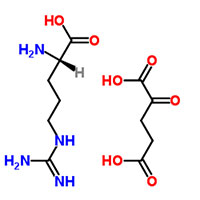L-arginine alpha ketoglutarate (1:1)
Nanjing Finechem Holdings Co., LTD
Synonyms
L-Arginine mono(2-oxoglutarate)
UNII-TVJ23A89RU
EINECS 240-882-6
ARGININE AKG(P)
L-Argininealpha-ketoglutarate
L-Arginine 2-oxoglutarate
L-Arginine α-ketoglutarate
MFCD00216455
(S)-2-Amino-5-guanidinopentanoic acid compound with 2-oxopentanedioic acid
L-Arginine, compd. with 2-oxopentanedioic acid (1:1)
2-Oxopentanedioic acid - L-arginine (1:1)
Product Description
Introduction:
L-Arginine L-Aspartate is a significant chemical compound with diverse applications in the chemical
industry. This product introduction aims to provide an overview of L-Arginine L-Aspartate, covering its
raw materials, production process, market trends, and the current status of amino acids in the
industry.
Raw Materials:
L-Arginine L-Aspartate is synthesized using L-arginine and L-aspartic acid as the primary raw materials.
L-arginine, an essential amino acid, and L-aspartic acid, a nonessential amino acid, serve as the
precursors for the synthesis of L-Arginine L-Aspartate.
Production Process:
The production process of L-Arginine L-Aspartate involves the following steps:
Step 1: Reaction - L-arginine and L-aspartic acid are combined and reacted under controlled conditions,
typically in an aqueous solution or appropriate solvent, to form L-Arginine L-Aspartate. The reaction
may involve the addition of suitable catalysts or reagents to facilitate the formation of the
compound.
Step 2: Purification and refinement - The resulting L-Arginine L-Aspartate is purified and refined using
techniques such as filtration, crystallization, and chromatography to achieve the desired level of
purity.
Market Trends:
The market demand for L-Arginine L-Aspartate has been steadily increasing due to its diverse
applications across various industries. Here are some key market trends:
Pharmaceuticals: L-Arginine L-Aspartate is used in the pharmaceutical industry. It is often included in
formulations targeting cardiovascular health, as L-arginine is known to support healthy blood flow and
nitric oxide production. Additionally, L-Arginine L-Aspartate may have potential benefits in improving
exercise performance and supporting muscle recovery.
Sports Nutrition: L-Arginine L-Aspartate finds applications in the sports nutrition industry. It is used
as a dietary supplement for athletes and individuals involved in physical activities. It is believed to
enhance exercise performance, promote muscle growth, and assist in post-workout recovery.
Current Status of Amino Acids:
Amino acids play a crucial role in various sectors, including pharmaceuticals, food additives, animal
nutrition, and agriculture. They are the building blocks of proteins and have essential functions in the
human body. L-arginine and L-aspartic acid are among the important amino acids used in various
industries.
Conclusion:
L-Arginine L-Aspartate, derived from the combination of L-arginine and L-aspartic acid, holds
significant value in the chemical industry. Its production involves the reaction of the two amino acids,
followed by purification and refinement. The market demand for L-Arginine L-Aspartate is driven by its
applications in the pharmaceutical industry for cardiovascular health and in the sports nutrition
industry for performance enhancement and muscle growth. Amino acids continue to be essential components
in various industries, contributing to advancements in chemical applications and human health.





